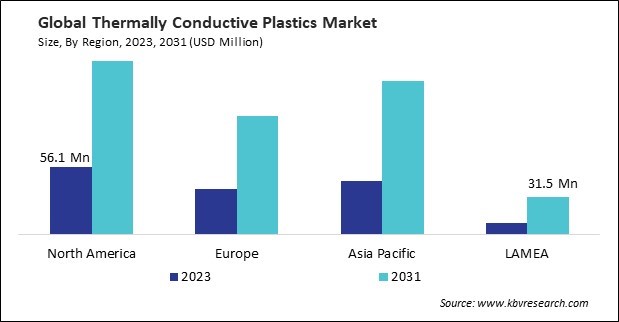The Thermally Conductive Plastics Market is Predict to reach USD 402.5 Million by 2031, at a CAGR of 13.5%
Special Offering :
Industry Insights | Market Trends | Highest number of Tables | 24/7 Analyst Support
Thermally Conductive Plastics Market Growth, Trends and Report Highlights
According to a new report, published by KBV research, The Global Thermally Conductive Plastics Market size is expected to reach $402.5 million by 2031, rising at a market growth of 13.5% CAGR during the forecast period. In the year 2023, the market attained a volume of 38,195.6 tonnes, experiencing a growth of 33.7% (2020-2023).
The thermally conductive plastics market has experienced significant expansion in recent years, driven by growing demand from the automotive, electronics, aerospace, and healthcare industries. The growth is credited to the rising uptake of thermally conductive plastics for various applications, including LED lighting, electronic enclosures, heat sinks, battery thermal management, and automotive components. Factors such as the need for lightweight materials, advancements in thermal management technologies, emphasis on energy efficiency, and the rising demand for electronic devices with improved thermal performance have propelled the market forward.

The Polyamide segment is leading the Global Thermally Conductive Plastics Market by Type in 2023; thereby, achieving a market value of $93.5 million by 2031. Polyamide resins can be easily molded into complex shapes, allowing for intricate designs in various applications. This design versatility appeals to industries seeking customized solutions for their thermal management needs. Also, polyamide-based thermally conductive plastics can offer cost savings in manufacturing and assembly processes.
The Industrial segment would register a CAGR of 14% during (2024 - 2031). With the rise of automation in various industrial processes, there’s a greater need for thermal management solutions to maintain optimal operating temperatures of electronic components, motors, and other machinery. Thermally conductive plastics play a vital role in ensuring the reliability and efficiency of automated systems.
Full Report: https://www.kbvresearch.com/thermally-conductive-plastics-market/
The North America region dominated the Global Thermally Conductive Plastics Market by Region in 2023; thereby, achieving a market value of $144.6 million by 2031. The Asia Pacific region is poised to grow at a CAGR of 14.2% during (2024 - 2031). Additionally, The Europe region would witness a CAGR of 13% during (2024 - 2031).
List of Key Companies Profiled
- Celanese Corporation
- SABIC (Saudi Arabian Oil Company)
- BASF SE
- Koninklijke DSM N.V.
- DuPont de Nemours, Inc.
- Lanxess AG
- Ensinger GmbH
- Toray Industries, Inc.
- Kaneka Corporation
- Covestro AG
Thermally Conductive Plastics Market Report Segmentation
By Type (Volume, Tonnes, USD Million, 2020-2031)
- Polyamide
- Polycarbonate
- Polyphenylene Sulfide
- Polyetherimide
- Polybutylene Terephthalate
- Polysulfones
- Others
By End-use (Volume, Tonnes, USD Million, 2020-2031)
- Electrical & Electronics
- Automotive
- Industrial
- Aerospace
- Healthcare & Pharma
- Telecommunications
- Others
By Geography (Volume, Tonnes, USD Million, 2020-2031)
- North America
- US
- Canada
- Mexico
- Rest of North America
- Europe
- Germany
- UK
- France
- Russia
- Spain
- Italy
- Rest of Europe
- Asia Pacific
- China
- Japan
- India
- South Korea
- Singapore
- Malaysia
- Rest of Asia Pacific
- LAMEA
- Brazil
- Argentina
- UAE
- Saudi Arabia
- South Africa
- Nigeria
- Rest of LAMEA
Related Reports:



